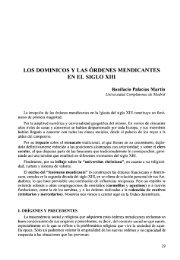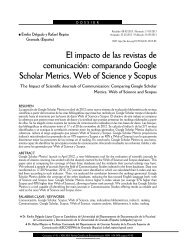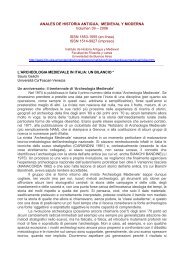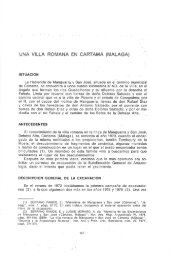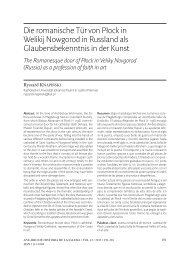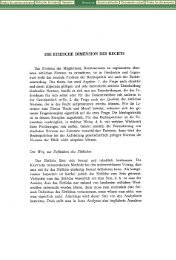Roslyn M. Frank 1.0. Introduction In the first chapter of this ... - Dialnet
Roslyn M. Frank 1.0. Introduction In the first chapter of this ... - Dialnet
Roslyn M. Frank 1.0. Introduction In the first chapter of this ... - Dialnet
You also want an ePaper? Increase the reach of your titles
YUMPU automatically turns print PDFs into web optimized ePapers that Google loves.
124<br />
<strong>Roslyn</strong> M. <strong>Frank</strong><br />
<strong>this</strong> fashion adults impress upon <strong>the</strong>ir <strong>of</strong>fspring <strong>the</strong> importance <strong>of</strong> carrying out<br />
certain ritual practices that <strong>the</strong>y <strong>the</strong>mselves no longer perform or believe in.<br />
<strong>In</strong> <strong>this</strong> case, <strong>the</strong>re is a sort <strong>of</strong> collusion between two generations. On <strong>the</strong> one<br />
hand, although <strong>the</strong> parents portray <strong>the</strong>mselves as believers in front <strong>of</strong> <strong>the</strong>ir <strong>of</strong>fspring,<br />
<strong>the</strong>y <strong>the</strong>mselves are situated, cognitively, on <strong>the</strong> outside, and from that<br />
vantage point <strong>the</strong>y view <strong>the</strong> belief and/or activity as appropriate for children but<br />
not for adults. <strong>In</strong> <strong>this</strong> respect, <strong>the</strong>re is a kind <strong>of</strong> tacit collaboration on <strong>the</strong> part <strong>of</strong><br />
<strong>the</strong> parents in terms <strong>of</strong> conserving <strong>the</strong> belief and social practices related to it.<br />
While <strong>the</strong> parents no longer represent <strong>the</strong> agents who believe in <strong>the</strong> efficacy <strong>of</strong><br />
carrying out <strong>the</strong> social practice, <strong>the</strong>y continue to be active participants in <strong>the</strong><br />
sense that <strong>the</strong>y insist on fostering <strong>the</strong> belief in <strong>the</strong>ir own children. Naturally,<br />
over time even <strong>the</strong> participation by children can become fur<strong>the</strong>r demeaned, e.g.,<br />
consumerized where <strong>the</strong> material trappings <strong>of</strong> <strong>the</strong> practice and/or purely its entertainment<br />
value become <strong>the</strong> focus <strong>of</strong> <strong>the</strong> performance.<br />
As we shall soon see, a typical example <strong>of</strong> <strong>this</strong> is represented by <strong>the</strong> degeneration<br />
<strong>of</strong> <strong>the</strong> phenomenon referred to as «good-luck visits», discussed earlier<br />
(<strong>Frank</strong> 2008b), where groups <strong>of</strong> adults wearing masks, <strong>of</strong>ten accompanied by a<br />
«bear», moved through <strong>the</strong> community, visiting one household after ano<strong>the</strong>r, in<br />
an action that was considered to bring «good-luck» and protect <strong>the</strong> householders<br />
and <strong>the</strong>ir farm animals against evil influences. <strong>In</strong> o<strong>the</strong>r words, in times past<br />
<strong>the</strong> «good luck visits» were performed by adults with specific purposes in mind. 17<br />
As we have noted, <strong>the</strong> visitations were understood to have a cleansing or healing<br />
function and it was not unusual for <strong>the</strong> «bear» character to be played by a<br />
flesh and blood bear.<br />
<strong>In</strong>deed, one <strong>of</strong> <strong>the</strong> principle reasons behind <strong>the</strong> persistence <strong>of</strong> such performances<br />
is <strong>the</strong> fact that <strong>the</strong> motley crew <strong>of</strong> masked actors along with <strong>the</strong>ir earthly<br />
bear or a man dressed as a bear was believed to be fully capable <strong>of</strong> carrying<br />
away <strong>the</strong> maladies and misfortunes <strong>of</strong> <strong>the</strong>ir households visited and/or <strong>the</strong> entire<br />
community (<strong>Frank</strong> 1996, 2005; Vukanovitch 1959). Consequently, <strong>the</strong> performances<br />
were considered to be <strong>of</strong> fundamental importance to all members <strong>of</strong> <strong>the</strong><br />
community: a method <strong>of</strong> insuring <strong>the</strong> health and well being <strong>of</strong> <strong>the</strong> social collective.<br />
At <strong>the</strong> same time, <strong>the</strong> «good luck visits» acted as a complex and resilient<br />
mechanism in terms <strong>of</strong> <strong>the</strong>ir ability to insure <strong>the</strong> storage and transmission <strong>of</strong> <strong>the</strong><br />
ursine belief system from one generation to <strong>the</strong> next, even though over time <strong>the</strong><br />
17 For a detailed discussion <strong>of</strong> <strong>the</strong> typology <strong>of</strong> <strong>the</strong> «good luck visits», cf. Halpert (1969). For<br />
additional bibliography and a discussion <strong>of</strong> modern versions <strong>of</strong> <strong>the</strong> performance, cf. <strong>the</strong> collection<br />
<strong>of</strong> essays in Halpert and Story (1969).



